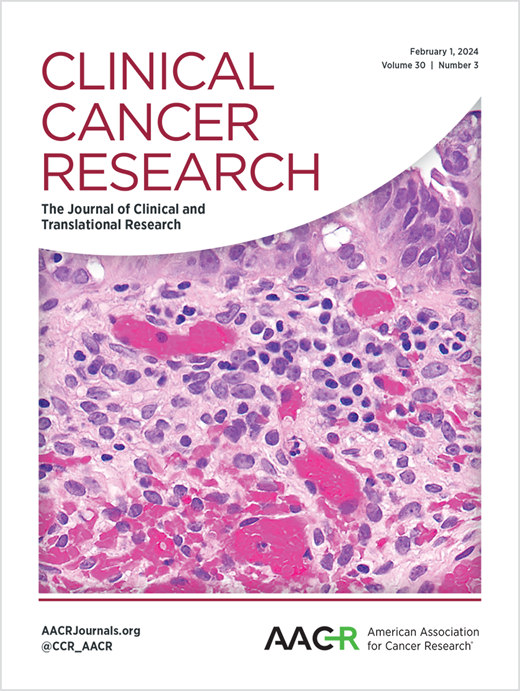Phase 1b Study of the Immunocytokine Simlukafusp alfa (FAP-IL2v), in Combination with Cetuximab in Patients with Head and Neck Squamous Cell Carcinoma.
IF 10
1区 医学
Q1 ONCOLOGY
引用次数: 0
Abstract
PURPOSE This phase 1b trial evaluated FAP-IL2v, a novel immune-cytokine engineered to minimize CD25-mediated toxicities, in combination with cetuximab, in patients with recurrent, unresectable, or metastatic head and neck squamous cell carcinoma (HNSCC). PATIENTS AND METHODS Patients received FAP-IL2v either on a continuous weekly (QW) schedule, or QW for 4 weeks and then every 2 weeks (Q2W). Cetuximab was dosed at QW or Q2W schedules. The primary objectives were to evaluate the safety and tolerability, maximum tolerated dose (MTD), pharmacokinetics, and clinical activity for the combination of FAP-IL2v with cetuximab. Exploratory objectives included pharmacodynamic analyses. RESULTS A total of 58 patients were enrolled, 19 patients into the dose-escalation, and 39 patients into the expansion part. The MTD of FAP-IL2v was defined as 10 mg (QW/Q2W) in combination with cetuximab (500 mg/m2, Q2W), which was further tested in the expansion part. The most common FAP-IL2v-related adverse events with a grade 3 or 4 severity were hypophosphatemia (19%), lymphopenia (16%), and infusion-related reaction (14%). The pharmacokinetics of FAP-IL2v in combination with cetuximab was similar to that after administration as monotherapy. Consistent with the proposed mode-of-action, FAP-IL2v preferentially expanded intratumoral NK and CD8 T cells. Four patients achieved a partial response, the objective response rate was 7% (95% CI: 3.2, 14.7). CONCLUSIONS The safety profile of FAP-IL2v in combination with cetuximab was acceptable and pharmacodynamic markers support the proposed mode-of-action of this combination, but the overall low antitumor activity does not warrant further clinical exploration in HNSCC. [Part C of Study BP29842 (NCT02627274).].免疫细胞因子 Simlukafusp alfa (FAP-IL2v) 与西妥昔单抗联合治疗头颈部鳞状细胞癌患者的 1b 期研究。
目的这项 1b 期试验评估了 FAP-IL2v 与西妥昔单抗联合治疗复发性、不可切除性或转移性头颈部鳞状细胞癌 (HNSCC) 患者的效果,FAP-IL2v 是一种新型免疫细胞因子,可最大程度地减少 CD25 介导的毒性。西妥昔单抗按QW或Q2W计划给药。主要目的是评估FAP-IL2v与西妥昔单抗联合用药的安全性和耐受性、最大耐受剂量(MTD)、药代动力学和临床活性。结果共有58名患者入组,其中19名患者进入剂量递增期,39名患者进入扩增期。FAP-IL2v的MTD被定义为10毫克(QW/Q2W)与西妥昔单抗(500毫克/平方米,Q2W)联用,并在扩增部分进行了进一步测试。与FAP-IL2v相关的最常见的3级或4级严重不良事件是低磷血症(19%)、淋巴细胞减少症(16%)和输液相关反应(14%)。FAP-IL2v与西妥昔单抗联用的药代动力学与单药治疗相似。与提出的作用模式一致,FAP-IL2v优先扩增瘤内NK和CD8 T细胞。结论:FAP-IL2v与西妥昔单抗联合用药的安全性是可以接受的,药效学指标也支持这种联合用药的作用模式,但总体抗肿瘤活性较低,不值得在HNSCC中进行进一步的临床探索。[BP29842研究(NCT02627274)C部分]。
本文章由计算机程序翻译,如有差异,请以英文原文为准。
求助全文
约1分钟内获得全文
求助全文
来源期刊

Clinical Cancer Research
医学-肿瘤学
CiteScore
20.10
自引率
1.70%
发文量
1207
审稿时长
2.1 months
期刊介绍:
Clinical Cancer Research is a journal focusing on groundbreaking research in cancer, specifically in the areas where the laboratory and the clinic intersect. Our primary interest lies in clinical trials that investigate novel treatments, accompanied by research on pharmacology, molecular alterations, and biomarkers that can predict response or resistance to these treatments. Furthermore, we prioritize laboratory and animal studies that explore new drugs and targeted agents with the potential to advance to clinical trials. We also encourage research on targetable mechanisms of cancer development, progression, and metastasis.
 求助内容:
求助内容: 应助结果提醒方式:
应助结果提醒方式:


